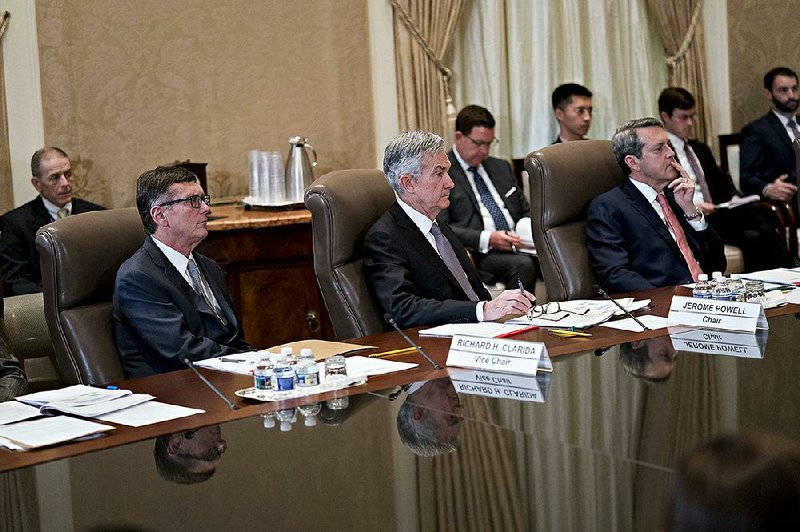WASHINGTON -- The Federal Reserve Board on Monday proposed easing key post-crisis regulations for the country's biggest banks, despite concerns from one member that the proposal goes too far.
Under the plan, big banks such as JPMorgan Chase and Bank of America would have to submit their "living wills" -- plans for their closure during another economic crisis -- every four years instead of every year. Slightly smaller banks, including Capital One and Deutsche Bank, would have to file their plans once every six years.
The public can submit comments on the proposed changes through June 21. It is unclear when the Fed would finalize them.
The proposal comes as President Donald Trump's administration continues to look for ways to curtail the regulatory burden faced by the banking industry, a decade after the global financial crisis. The industry has complained that many of the strictest rules are too cumbersome and costly.
The industry has specifically targeted the yearly "living wills," a requirement that banking institutions have a plan to close their doors in an emergency without harming the economy or requiring a taxpayer bailout. Industry officials have said that banks are healthier today than before the financial crisis and that the frequent check-ins are unnecessary.
Fed officials have reviewed banks' living wills for seven years and say the change is warranted. Despite the current yearly requirement, reviewing a single "living will" submission for the biggest banks typically takes two years already, the officials said.
"The proposal seeks to increase the efficiency of firms without compromising the strong resiliency of the financial sector," Fed Vice Chairman for Supervision Randy Quarles said in a statement.
Under the proposal, big banks would submit a slimmed-down version of "living wills" in between the traditional one they file every four or six years. Most U.S. banks with less than $250 billion in assets, such as American Express and M&T Bank, would be exempt from the living-will requirement.
The change for the smallest banks was called for under a law passed last year rolling back key regulations. But the help being offered to the biggest banks goes beyond the legislation, and some critics say the banking industry is already reporting record profits without a rollback of the rules.
Lael Brainard, a member of the Fed's Board of Governors and an Obama-era appointee, said that she would support easing the rules but that the proposal could "leave the system less safe."
"We saw clearly in the crisis that the failure of one or more large banking organizations may lead to severe stress in the financial system," Brainard said in a statement. "I am concerned the proposals ... would weaken the important safeguard put in place to address vulnerabilities that proved extremely damaging in the crisis."
The Federal Reserve also proposed easing regulatory requirements for some foreign banks with U.S. operations. Those banks would face roughly the same level of scrutiny as their U.S.-based competitors, under the proposal.
Depending on what final calculations the Fed lands on, several foreign lenders -- including Deutsche Bank, Barclays, Credit Suisse, Mitsubishi UFJ Financial Group, Mizuho Financial Group and Toronto-Dominion Bank -- could be slotted into the second tier, just below a group of U.S. banks with major global footprints. A second-level designation would come with routine stress testing and the most stringent rules for capital. The banks would also be subjected to the same liquidity demands as the U.S. megabanks.
"Because the U.S. operations of most foreign banks tend to have a larger cross-border profile, greater capital markets activities and higher levels of short-term funding, they often present greater risk than a simpler, more traditional domestic bank," Fed Chairman Jerome Powell said in a statement on the proposal.
The new system, which draws Credit Suisse and UBS into such liquidity rules for the first time, is being proposed in cooperation with the Office of the Comptroller of the Currency and the Federal Deposit Insurance Corp. The Fed estimated it could boost overall liquidity demands by as much as 4 percent for foreign banks in the U.S. The reason for uncertainty over which category banks fall into stems from the fact that the Fed needs more information to measure "cross-jurisdictional" activity.
Banks in the third tier -- which is expected to include HSBC Holdings, UBS Group and Royal Bank of Canada -- are likely to benefit from marginally reduced capital requirements. Those at the fourth level -- including Banco Santander SA, Societe General SA and BNP Paribas SA -- would see even lower stress-test, capital and leverage constraints.
Information for this article was contributed by Renae Merle of The Washington Post and by Jesse Hamilton of Bloomberg News.
Business on 04/09/2019
